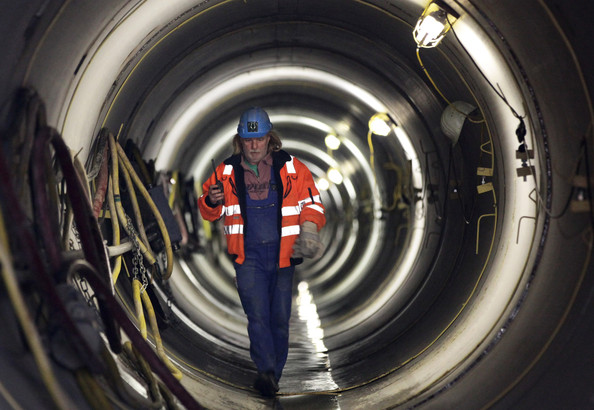
Nord Stream–OPAL–Gazelle: Another Ukraine-Bypass Route for Gazprom
Publication: Eurasia Daily Monitor Volume: 11 Issue: 22
By:

According to Russia’s state-owned PRIME business news agency, European Union Energy Commissioner Guenther Oettinger has told journalists that the European Commission is set to reach an agreement with the Russian government on Gazprom’s access to the OPAL pipeline in Germany (PRIME, January 27). Russian President Vladimir Putin, concluding the EU-Russia summit in Brussels on January 28, hinted that European authorities would allow Gazprom to use as much as 100 percent of the OPAL pipeline’s capacity (see EDM, January 30, 31).
If approved by the Commission as purported, such a decision would practically nullify the application of the Third Energy Legislation Package to OPAL, failing to implement third-party access after having already failed to implement ownership unbundling; and it could almost pre-determine a similar solution regarding OPAL’s counterpart NEL pipeline, both lines being co-owned by Gazprom in Germany (see below).
Second, Gazprom’s exclusive or discretionary use of OPAL would embolden the Russian government to seek a comparable status for Gazprom’s South Stream pipeline project on EU territory. This would certainly affect the negotiations that the EU has just agreed to start with the Russian government about the status of South Stream.
And third, authorizing Gazprom’s full-throttle use of OPAL would sacrifice Ukraine’s interests, squeezing the Ukrainian gas transit system between the bypass threat from South Stream and a bypass threat from the north through the Nord Stream–OPAL–Gazelle pipelines. Russia plans to re-direct gas volumes from Ukraine’s transit system into South Stream; and it is already diverting volumes from Ukrainian pipelines into the Nord Stream route to Germany on the Baltic seabed.
Nord Stream feeds into OPAL in Germany, which in turn feeds into the Gazelle pipeline in the Czech Republic. OPAL and Gazelle, both being sourced from Nord Stream, are opening a new route for Gazprom into EU territory. These pipelines were completed in 2012, 2011, and 2013, respectively. Nord Stream, 51 percent Gazprom-owned, is the largest-capacity offshore pipeline in Europe at 55 billion cubic meters (bcm) annually. OPAL and Gazelle, at 35 bcm and 30 bcm per year, respectively, are the largest-capacity onshore pipelines in EU territory.
Gazprom controls OPAL in Germany through the Gazprom-Wintershall joint company Gascade Gastransport, holding 80-percent ownership and operating rights (opal.gastransport.de, gascade.de, accessed January 30, 2014).
From the landfall point of Nord Stream on the Baltic coast at Lubmin (near Greifswald), OPAL runs southward to the German-Czech border, connecting with the Gazelle pipeline at the Olbernhau-Brandov gas transfer stations. Gazprom has several marketing options with OPAL. This line connects directly with the STEGAL pipeline, which runs across central Germany. OPAL is also designed to connect indirectly, through the Czech Republic and the Gazelle pipeline, with the MEGAL pipeline in Germany. Using the Gazelle line for transit, Gazprom would retain ownership of the gas volumes to be delivered into the MEGAL pipeline. The latter runs from the Rozvadov-Waidhaus transfer stations on the Czech-German border into Bavaria, across southern Germany, and onward into eastern France.
A consortium of Western shareholders, NET4GAS, owns and operates the Gazelle pipeline in the Czech Republic. Russian gas volumes entering the Czech Republic from the north, through OPAL, can replace the Russian volumes that traditionally entered the Czech Republic—whether for local use or onward transit—from the east by the Ukraine-Slovakia transit corridor. Ultimately, Ukraine stands to lose gas transit volumes on two counts. Volumes bound for Germany can be re-routed from Russia directly into Nord Stream, while volumes bound for the Czech Republic can simply be subtracted from the total transit via Ukraine. This would involve revenue losses for Ukraine and would reduce the market value of its gas transit system.
EU-Russia negotiations on the status of OPAL are now in the end-game phase. The EU Commission started the negotiations belatedly in 2012 with the Russian government, one year after OPAL’s construction had been completed. Up to that point, German regulatory authorities had granted OPAL a national exemption from the third-party-access requirement—i.e., sole use of the pipeline, denying access to eventual competitor suppliers of gas. The EU Commission overruled that German decision, pending a negotiated resolution. The Russian government has given up its pretense that the Third Energy Legislative Package should not apply to OPAL. Instead, the Russian government and German authorities request that OPAL be released from the third-party-access clauses. That access is defined as non-discriminatory, but Moscow has attempted in the negotiations preventively to deny access to OPAL for gas producers that are not Nord Stream shareholders (see EDM, January 31).
Real unbundling of OPAL from Gazprom’s co-ownership (as distinct from its cosmetic unbundling through Gascade) seems beyond reach. Non-discriminatory third-party-access looks more theoretical than practical, as long as independent gas suppliers are not in sight at the entry point to OPAL. The negotiators envisage two possible alternative options. One would involve Gazprom (Gascade) making available certain portions of OPAL’s capacity to other gas suppliers through public auctions from time to time. Another option under discussion would apparently involve Gazprom selling certain gas volumes from OPAL on the open market in the Czech Republic.
Both proposals thus far look like poor substitutes for the real application of the Third Package. And gas volumes delivered by Gazprom through Nord Stream–OPAL–Gazelle into the Czech Republic would almost ipso facto be diverted from the Ukrainian-Slovak transit corridor. Using that circuitous and expensive route, instead of the direct route, would underscore Gazprom’s political intention to bypass Ukraine, despite far higher transportation costs. It would also reveal Gazprom’s policy of building surplus export pipeline capacities—Nord Stream and potentially South Stream—most likely planned to remain under-utilized (see EDM, April 22, 2013).




